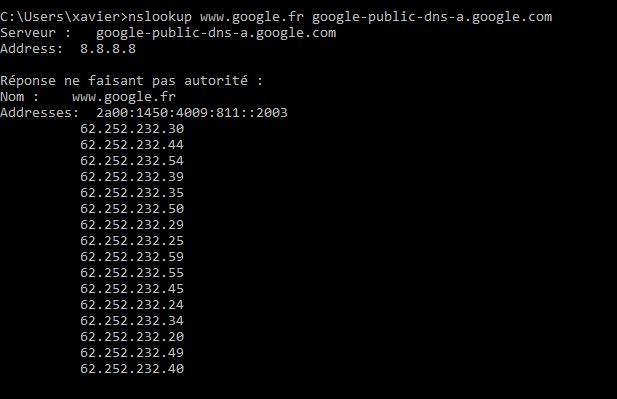Pingou is a powershell script that allows to test connectivity using ICMP and open TCP ports on a remote host. This command is meant to be easy to use, intuitive and faster than the built-in Test-Connection and Test-NetConnection cmdlets.
Link to the script : Pingou

I took inspiration on tPing, a great script that one of my colleagues wrote. But because there is no better way to learn than to do it myself, I took a few ideas and wrote mine from scratch.
ICMP
Pingou -destination www.google.fr

It is not visible on the screenshot but the response times are much faster than the Ping command that tests every second. Pingou has a default delay between tests set to 750ms and can be manually set to a minimum of 50ms.
TCP
Pingou -destination www.google.fr -port 80

A status of true means the port is open and false if closed (or could be a communication issue). The parameters buffer and hops can’t be used with the tcp ping as it is specific to icmp pings.
Hostname resolve
The script resolves automatically the hostname to ping. According to your DNS settings, a hostname can resolve one or multiple IPs (apologies for the screenshots in french but you’ll get it).
Nslookup using my ISP’s DNS : cache1.service.virginmedia.net

Nslookup using google’s DNS (the one I use) : google-public-dns-a.google.com
As you can see for some reason the VirginMedia DNS resolves only one IP when google’s ones resolve a lot more. In case it happens, the test will be issued to the first IP in the list (62.252.232.30 in this case).
Parameters
I could go through all the possibilities the script offers but the easiest is probably that you play with it or take a look at the few examples in the help of the script.
-
DESTINATION: Remote IP or hostname to test.
-
PORT: TCP port to check on the remote host, validate range is 1 to 65535.
-
COUNT: (-n) Number of test issued.
-
CONTINUOUS: (-t) Number of tests infinite. can be stopped with ctrl+c or by closing the invite.
-
TIMEOUT: (-w) Number of milliseconds after which a timeout is issued for each test.
-
DELAYMS: Number of milliseconds between each test.
-
HOPS: (-i) Number of hops after which the packet is dropped (TTL expired). Works only with ICMP tests.
-
BUFFER: (-l) Size in bytes of the buffer to send. Works only with ICMP tests.
Code
Pingou function
Function Pingou {
[CmdletBinding(DefaultParameterSetName=1)]
param(
[Parameter(Mandatory=$true,ValueFromPipeline = $True,position=0)]
[string]
$Destination,
[parameter(position=1)]
[ValidateRange(1,65535)]
[int]
$Port,
[parameter(parametersetname=2)]
[Alias('t')]
[switch]
$Continuous,
[parameter(parametersetname=1)]
[Alias('n')]
[int]
$Count = 4,
[Alias('w')]
[int]
$Timeout = 1000,
[ValidateRange(50,10000)]
[int]
$Delayms = 750,
[ValidateRange(1,255)]
[Alias('i')]
[int]
$Hops = 128,
[ValidateRange(1,255)]
[Alias('l')]
[int]
$Buffer = 32
)
#$ErrorActionPreference = "SilentlyContinue"
$Resolve = [System.Net.Dns]::GetHostAddresses($Destination).IPAddressToString
IF ($Resolve.count -gt 1) {$Resolve = $Resolve[0]}
IF ($Resolve) {
IF ($Port) {
While ($i -lt $Count) {
Port-Ping -IP $Resolve -Port $Port -Timeout $Timeout
IF (!$Continuous) {$i++}
Sleep -Milliseconds $Delayms
}
} ELSE {
$icmpping = New-Object system.Net.NetworkInformation.Ping
$icmpoptions = New-Object System.Net.NetworkInformation.PingOptions($Hops,$false)
While ($i -lt $Count) {
Icmp-Ping -IP $Resolve -Timeout $Timeout -icmpOption $icmpoptions -Buffer $Buffer
IF (!$Continuous) {$i++}
Sleep -Milliseconds $Delayms
}
}
} ELSE { # ELSE RESOLVE
Write-Warning "cannot resolve $Destination"
}
}
ICMP and TCP Subfunctions
Function Port-Ping {
param(
[Parameter(ValueFromPipeline = $True)]
[string]
$IP,
[ValidateRange(1,65535)]
[int]
$Port,
[int]
$Timeout
)
$before = get-date
$PortPing = New-Object System.Net.Sockets.TCPClient
$PortConnect = $PortPing.beginConnect("$IP",$Port,$null,$null)
While (((get-date) -lt $before.AddMilliseconds($Timeout)) -and ($PortPing.Connected -ne "true")) {}
$timems = [math]::round(((get-date) - $before).TotalMilliseconds,0)
[pscustomobject]@{
LocalEndpoint = $PortPing.Client.LocalEndPoint
RemoteEndpoint = $PortPing.Client.RemoteEndPoint
Status = $PortPing.Connected
Timems = $timems
}
$PortPing.Close()
}
Function Icmp-Ping {
param(
[Parameter(ValueFromPipeline = $True)]
[string]
$IP,
[int]
$Timeout,
[int]
$Buffer,
[System.Net.NetworkInformation.PingOptions]
$icmpOption
)
$icmpconnect = $icmpping.Send("$IP",$Timeout,$buffer,$icmpoptions)
[pscustomobject]@{
RemoteEndpoint = $IP
Bytes = $buffer
Time = IF ($icmpconnect.Status -eq "Success") {$icmpconnect.RoundtripTime} ELSE {$icmpconnect.Status}
TTL = $icmpconnect.Options.Ttl
}
}
